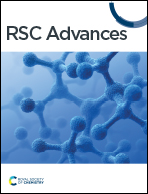ReaxFF MD and detailed reaction kinetic study on the thermal cracking and partial combustion of anisole: a biomass model tar compound
Abstract
Methods of partial oxidation for biomass tar conversion were studied based on their detailed reaction mechanism. The good accuracy of the modeling results compared with the experimental data indicate that the model was reasonable. Anisole was chosen as the tar model component for partial combustion with equivalence ratios (ER) from 0 to 0.8. The results show that oxygen promotes the pyrolysis of anisole and thereby the tar conversion rate. An appropriate amount of oxygen could crack tar into flammable small-molecule gases (H2, CO) and inhibit the generation of polycyclic aromatic hydrocarbon (PAH) compounds. In addition to the introduction of active free radicals, partial oxidation could also improve tar cracking by exothermic oxidation to produce amounts of heat. Typical PAH production was studied based on the rate of product formation (ROP). The results show that active radicals, such as H and OH, promote tar cracking. A detailed reaction pathway for tar conversion was built. Staged oxygen supply benefited the cracking of tar into small-molecule gases and inhibited the formation of PAHs.



 Please wait while we load your content...
Please wait while we load your content...